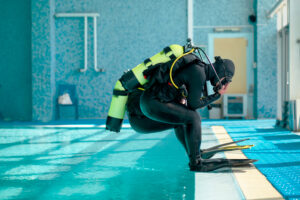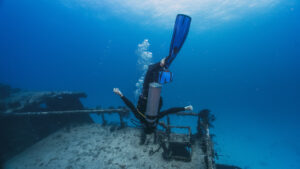What is Integrated Weights?
Integrated weights refer to a type of weight system used in scuba diving, where weights are incorporated into the diver’s buoyancy control device (BCD) rather than being worn on a separate weight belt. This system enhances comfort and stability for the diver by distributing the weight more evenly across the body. The integrated weights can be quickly and easily removed in an emergency, adding an important safety feature to the diving experience. This entry will explore the historical development, design mechanisms, advantages, challenges, technical advancements, and diver experiences associated with integrated weight systems.
Historical Development
The use of weights in scuba diving has been essential since the early days of the sport. Traditionally, divers used weight belts, which were simple straps with attached lead weights. These belts helped counteract the buoyancy of the wetsuit and other gear, allowing divers to achieve neutral buoyancy underwater. However, weight belts had several drawbacks, including discomfort and the tendency to shift during a dive, potentially leading to instability.
The concept of integrated weights began to emerge in the late 20th century as a response to these issues. Divers and manufacturers sought a more ergonomic and practical solution to weight distribution. The first integrated weight systems were introduced in the 1990s, featuring pockets built into the BCD where weights could be securely placed. This innovation marked a significant shift in diving equipment design, prioritizing diver comfort and safety.
As integrated weight systems gained popularity, manufacturers continued to refine the designs. Early models had limitations, such as difficulty in removing weights quickly during emergencies. Over time, advancements in materials and engineering led to more sophisticated systems that addressed these concerns. The adoption of integrated weights became more widespread, and today they are a standard feature in many modern BCDs, reflecting their successful evolution from a niche innovation to a mainstream component of diving gear.
Design and Mechanism
Integrated weight systems are designed to be user-friendly and efficient. Typically, they consist of pockets or compartments built into the sides of the BCD. These pockets can hold various types of weights, such as lead blocks or soft weight pouches filled with lead shot. The weights are secured with fasteners like Velcro, zippers, or clips to prevent accidental loss.
One of the key features of integrated weight systems is the quick-release mechanism. In an emergency, divers need to be able to drop their weights rapidly to achieve positive buoyancy and ascend to the surface. Integrated systems often include handles or pull-tabs that allow the weights to be jettisoned with a single motion. This feature significantly enhances safety by enabling a swift response to underwater emergencies.
The design of integrated weight systems varies among manufacturers, with some offering modular systems that allow divers to customize the amount and placement of weights. This flexibility is particularly beneficial for divers with different body types and buoyancy needs. For example, some BCDs feature trim weight pockets located on the back or shoulders to help fine-tune buoyancy and balance.
Integrated weights also contribute to a streamlined profile, reducing drag and improving hydrodynamics. By eliminating the need for a separate weight belt, divers experience less bulk and restriction, which can enhance overall maneuverability underwater. This streamlined design is especially advantageous in environments where reduced drag is critical, such as cave or wreck diving.
Advantages of Integrated Weight Systems
Integrated weight systems offer numerous benefits that make them a preferred choice for many divers. One of the primary advantages is increased comfort. By distributing the weight across the BCD, these systems alleviate the pressure points and discomfort associated with traditional weight belts. This ergonomic design allows for longer and more enjoyable dives, as divers are less likely to experience fatigue or pain.
Another significant advantage is improved buoyancy control. Integrated weights help maintain a more natural and stable body position in the water. With weights positioned closer to the diver’s center of gravity, movements become more predictable and balanced. This stability is crucial for maintaining proper trim and avoiding unwanted buoyancy shifts, which can be challenging to manage with a weight belt.
Safety is a paramount concern in diving, and integrated weight systems address this by incorporating quick-release mechanisms. In an emergency, divers can quickly jettison their weights to achieve positive buoyancy and ascend safely. This feature is particularly vital in situations where rapid ascent is necessary, such as when dealing with equipment failure or medical emergencies. The ease of dropping weights can make a critical difference in avoiding accidents and ensuring a safe return to the surface.
Case studies and anecdotal evidence from divers highlight the practical benefits of integrated weights. Many report enhanced mobility and freedom of movement, which can significantly improve the diving experience. For instance, photographers and videographers often appreciate the unobstructed access to their equipment, while technical divers value the precise buoyancy adjustments that integrated weights facilitate.
Challenges and Considerations
Despite their advantages, integrated weight systems are not without challenges and considerations. One common issue is the potential for increased difficulty in managing and distributing weight. Unlike weight belts, which allow for easy adjustment by simply moving weights along the belt, integrated systems require careful planning to achieve the desired balance. Divers need to consider the placement and amount of weight in each pocket to maintain optimal trim and stability.
Another challenge is the maintenance and durability of integrated weight systems. The pockets and fasteners are subject to wear and tear, particularly in saltwater environments. Regular inspection and maintenance are essential to ensure that the weights remain securely in place and that the quick-release mechanisms function properly. Divers must be diligent in rinsing and drying their BCDs to prevent corrosion and prolong the lifespan of the integrated weight components.
Situational considerations also play a role in the effectiveness of integrated weight systems. The type of diving and environmental conditions can influence their performance. For example, in colder waters where thicker wetsuits or drysuits are used, the additional buoyancy may require more weight, potentially exceeding the capacity of the integrated pockets. In such cases, divers might need to supplement with a weight belt or other weighting options.
Divers who travel frequently should also consider the portability of their gear. Integrated weight systems add bulk to the BCD, which can be a concern for those trying to minimize luggage weight and space. Some manufacturers have addressed this by designing travel-friendly BCDs with removable weight pockets that can be packed separately.
Technical Advancements and Innovations
The continuous evolution of diving equipment has led to significant advancements in integrated weight systems. Modern designs incorporate a variety of innovative features aimed at enhancing functionality and safety. One notable development is the use of advanced materials, such as high-strength polymers and corrosion-resistant metals, which improve durability and reduce overall weight.
Innovations in weight pocket design have also made integrated systems more user-friendly. Magnetic closures and improved clip mechanisms provide secure fastening while allowing for easy removal and replacement of weights. These enhancements ensure that the weights stay in place during the dive but can be quickly released in an emergency.
Some integrated weight systems now feature modular designs that allow divers to customize their setup. Modular systems enable divers to add or remove weight pockets based on their specific needs and preferences. This flexibility is particularly valuable for technical divers who require precise weight distribution for different diving configurations.
Another area of advancement is the integration of digital technology. Some modern BCDs with integrated weights come equipped with electronic buoyancy control systems. These systems use sensors to monitor depth and pressure, automatically adjusting the amount of air in the BCD to maintain neutral buoyancy. While still relatively new, these digital systems represent a promising direction for the future of diving equipment.
The future of integrated weight systems looks promising, with ongoing research and development focused on further improving safety, comfort, and efficiency. As manufacturers continue to innovate, divers can expect to see even more advanced features and materials incorporated into their gear.
Diver Experiences and Community Feedback
The experiences and feedback from divers play a crucial role in shaping the development of integrated weight systems. Divers of all levels, from recreational to professional, have shared their insights and preferences, contributing to the continuous refinement of these systems.
Many divers report a positive shift in their diving experience after switching to integrated weights. The enhanced comfort and improved buoyancy control are frequently cited as significant benefits. Divers appreciate the elimination of pressure points and the even weight distribution, which contribute to a more relaxed and enjoyable dive.
Community feedback has also highlighted some areas for improvement. Some divers have expressed concerns about the durability of certain integrated weight systems, particularly in harsh environments. This feedback has driven manufacturers to invest in more robust materials and construction methods, addressing these issues to meet the demands of different diving conditions.
Professional divers and instructors often provide valuable insights based on their extensive experience. They emphasize the importance of proper training and familiarization with integrated weight systems, especially the quick-release mechanisms. Training agencies and dive schools have incorporated these systems into their curricula, ensuring that new divers are well-prepared to use them effectively.
Diver forums and online communities serve as valuable platforms for sharing experiences and recommendations. Divers discuss the pros and cons of various models, offering advice on the best options for different diving scenarios. This collective knowledge helps divers make informed decisions when selecting integrated weight systems.
Key Takeaways
Integrated weight systems have significantly enhanced the scuba diving experience by offering improved comfort, buoyancy control, and safety. While they present some challenges and require careful consideration, ongoing advancements and diver feedback continue to drive innovation in this field. As a result, integrated weights have become a staple in modern diving equipment, providing divers with a reliable and efficient means of managing their buoyancy underwater.

















